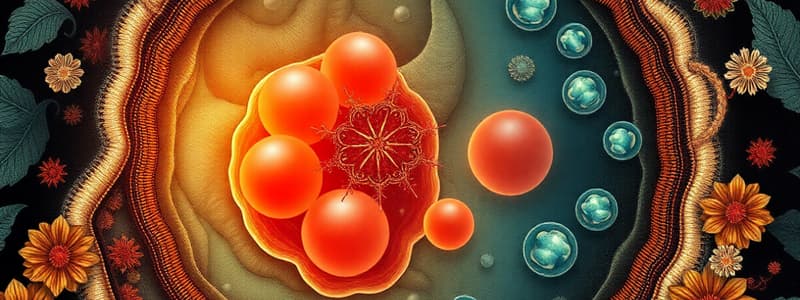Podcast
Questions and Answers
How does the structure of the plasma membrane relate to its function of regulating the movement of substances in and out of the cell?
How does the structure of the plasma membrane relate to its function of regulating the movement of substances in and out of the cell?
The plasma membrane's phospholipid bilayer with embedded proteins allows selective passage. The hydrophobic tails of the phospholipids prevent polar molecules from easily crossing, while transport proteins facilitate the movement of specific molecules.
Why is the presence of a double membrane in mitochondria essential for its function in cellular respiration?
Why is the presence of a double membrane in mitochondria essential for its function in cellular respiration?
The double membrane creates compartments (outer membrane, inner membrane, and matrix) that are essential for establishing proton gradients and housing the electron transport chain, both critical for ATP production during cellular respiration.
Differentiate between the functions of the rough endoplasmic reticulum (RER) and the smooth endoplasmic reticulum (SER) based on their structural differences.
Differentiate between the functions of the rough endoplasmic reticulum (RER) and the smooth endoplasmic reticulum (SER) based on their structural differences.
The RER, studded with ribosomes, is primarily involved in protein synthesis and transport, whereas the SER, lacking ribosomes, is responsible for lipid synthesis and transport.
Describe how the nucleus controls cellular activities by regulating substance exchange with the cytoplasm.
Describe how the nucleus controls cellular activities by regulating substance exchange with the cytoplasm.
How do centrioles contribute to cell division in animal cells, and why are they considered exclusive to animal cells?
How do centrioles contribute to cell division in animal cells, and why are they considered exclusive to animal cells?
Flashcards
Plasma Membrane
Plasma Membrane
A thin layer of proteins and phospholipids that controls what enters and exits the cell.
Cytoplasm
Cytoplasm
Gel-like substance filling the cell, where organelles are suspended and biochemical reactions occur.
Nucleus
Nucleus
The control center of the cell, directing synthesis and activity through DNA.
Mitochondria
Mitochondria
Signup and view all the flashcards
Golgi Apparatus
Golgi Apparatus
Signup and view all the flashcards
Study Notes
Animal Cell Structure and Function
- Focus on the structure of animal cells and their components
- Emphasis on understanding the organelles and their functions
- Labeling cell parts is more common than drawing the cell
Plasma Membrane
- Thin layer of proteins and phospholipids
- Regulates substance movement into and out of the cell
- Semi-permeable
Cytoplasm
- Gel-like medium where organelles are suspended
- Site of biochemical reactions like respiration and photosynthesis
Nucleus
- Controls cellular synthesis and activities
- Regulates substance exchange with the cytoplasm
- Chromatin is condensed chromosomes
- Nucleolus is located inside
- Nuclear pores connect to the endoplasmic reticulum
- Nucleoplasm is the space inside, surrounded by the nuclear envelope
Mitochondria
- Cylindrical organelles with a double membrane
- Site of cellular respiration
- Energy released as ATP
- Outer membrane, inner membrane (cristae), and matrix are key structures
Rough Endoplasmic Reticulum (Rough ER)
- Usually attached to the nucleus
- Transports proteins made by ribosomes
Smooth Endoplasmic Reticulum (Smooth ER)
- Synthesizes and transports lipids
- Not connected to the nucleus
Golgi Apparatus
- Packages and transports proteins and glycoproteins
- Vesicles budding off are a key feature
Ribosome
- Spherical organelles, free in cytoplasm or attached to rough ER
- Synthesizes proteins
Centrioles
- Exclusive to animal cells
- Form spindle fibers during cell division
Studying That Suits You
Use AI to generate personalized quizzes and flashcards to suit your learning preferences.




